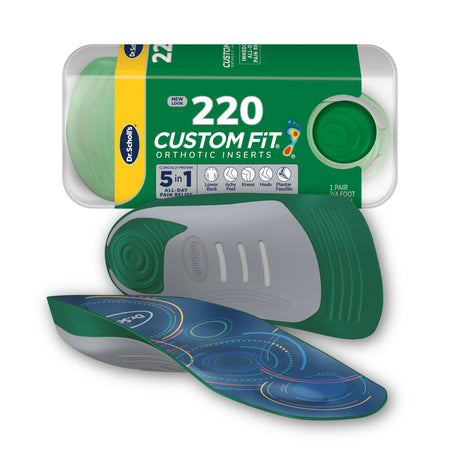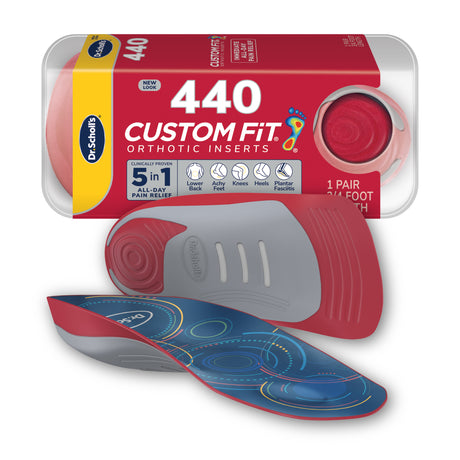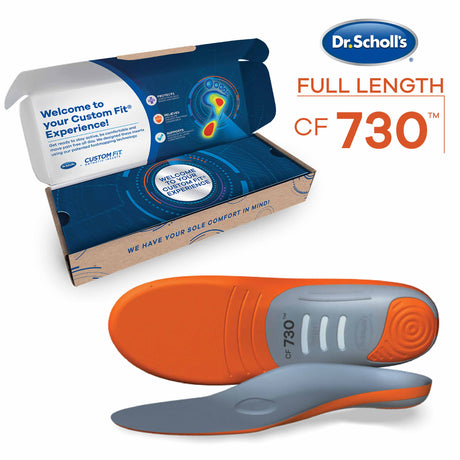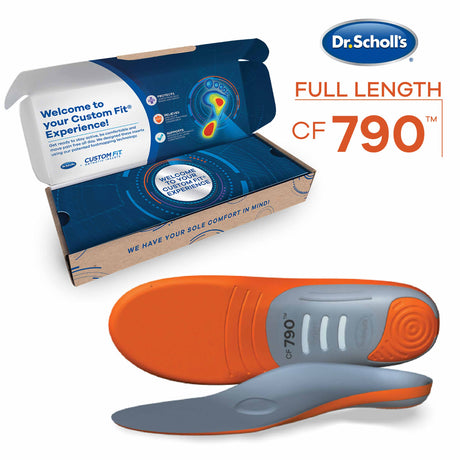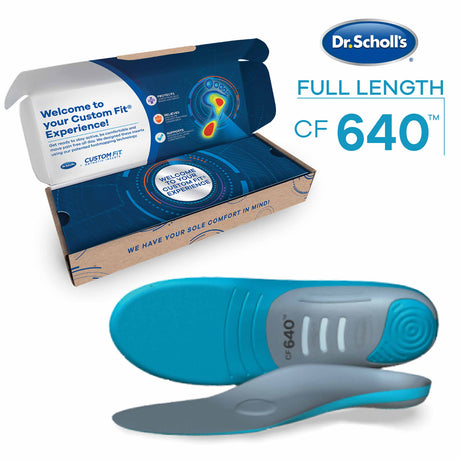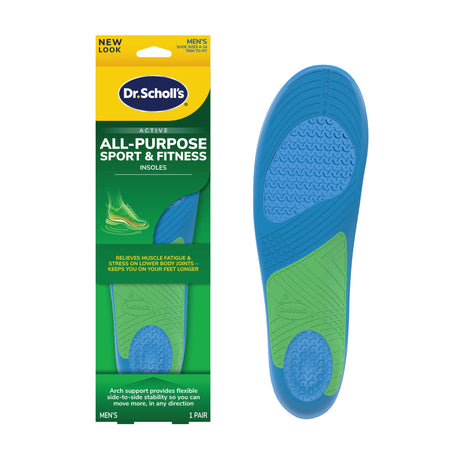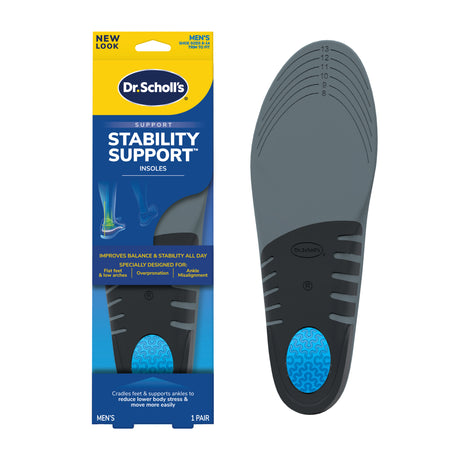Flat Feet FAQs
Economy shipping is FREE for orders over $25+!

There’s no fix for flat feet, a condition where the feet have little to no arch. In fact, all babies are born with flat feet but over time, normal arches will typically form in the feet of most children.
For adults who have flat feet due to anatomical factors or age, the condition is usually permanent. While surgery may be able to restore an arch in some individuals, it’s not usually recommended. Doctors usually only consider surgery in extreme cases where pain is severe and debilitating, and where conservative treatments have failed to provide relief.
Many people with flat feet have no pain or issues at all, and they don’t require any kind of treatment or therapy. For those experiencing pain and swelling, it’s important to first determine if the issue is flat feet or if there is some other cause. There are a number of options available to help manage the issue, including rest, cold therapy, over-the-counter pain relievers and foot exercises. Specialty shoes, orthotics and insoles such as Dr. Scholl’s® Stabilizing Support Insoles can also help provide support for flat feet.
Unfortunately, there is no real way to rebuild arches in flat feet. The only way to reconstruct fallen arches is with surgery, which is rarely recommended for flat feet. Acquired flat feet (a condition where there was once an arch but the feet become flat over time or following an injury) is usually permanent.
With acquired flat feet, treatment typically focuses on managing the symptoms of the condition rather than trying to correct the underlying problem by rebuilding the arches.
Exercises can help support the muscles in the feet in order to compensate for the lack of structural stability in flat feet. Here are two examples of exercises that can be helpful for flat feet:
• Heel raises — Start by standing with your feet flat on the floor. Raise your heels so that you’re putting your weight on the balls of your feet. Hold the position for about five seconds and then lower your heels back to the floor. Repeat five times.
• Arch lifts — Start from either a sitting or standing position. Lift your arches off the floor as far as you can without discomfort, shifting your weight to the outside edges of your feet. Make sure your toes and heels stay in contact with the ground. Hold the position for about five seconds and then relax, bringing your feet back to a natural standing position. Repeat five times.
If these exercises cause pain or discomfort, stop immediately. Consult your doctor if your pain is severe or persistent.
There is a fix for flat feet. Children with flat feet will typically outgrow the issue and develop an arch, usually by the time they reach the age of six. The only true way to create an arch in adults with flat feet is through surgery. However, surgery is not commonly recommended for flat feet.
For people with flat feet who don’t experience symptoms, no treatment is needed. When necessary, treatment for flat feet typically focuses on managing symptoms such as pain and swelling. Many people with flat feet are able to manage the issue with the help of regular rest and icing, pain relievers and shoes, insoles and orthotics that provide extra arch support such as Dr. Scholl’s® Pain Relief Orthotics for Arch Pain.
In many cases, you can join the military with flat feet. A common condition, flat feet no longer disqualifies people from the military. Some people with flat feet never experience any symptoms and are able to engage in normal physical activities with no trouble. However, some people with flat feet have symptoms that interfere with certain types of physical activity, and these symptoms may prevent them from joining the military. Talk to your doctor or a military recruiter if you have any questions or concerns.
When someone has flat feet, it means their feet have little arch or no arch at all. When someone has a normal arch, you’ll see a curve along the inside of the foot in the area between the ball of the foot and the heel. The arch of the foot usually forms during childhood but in some cases, the arch fails to form. In other cases, a normal arch forms but then the feet become flat later in life due to age, an injury or other contributing factors.
There are two main types of flat feet: flexible and rigid.
Most people with flat feet have the flexible type. This means they have an arch when there’s no pressure applied to the feet, such as when they’re in a seated position. However, when they stand or put pressure on the feet, the arch is no longer visible.
Rigid flat feet is less common. This is where there is no visible arch present at any time, even when there is no pressure applied to the feet.
Many people with flat feet never experience any symptoms at all and the condition doesn’t prevent them from leading a full, active life. In other cases, people with flat feet may be more susceptible to experiencing pain, fatigue and swelling in the feet as well as other areas of the body such as the knees and lower back.
You may able to tell if you have flat feet by observing your feet while in a standing position. If there is a visible curve on the inside of the foot and the arch doesn’t come into contact with the ground but rather rises above the ground, you most likely don’t have flat feet. On the other hand, if there is no visible curve and the entire surface of the sole of the foot comes into contact with the ground when you’re standing, you may have flat feet.
You can also perform what’s called a footprint test. Get your feet wet, step onto a hard surface and then step off. Make sure there’s a clear, visible footprint. If you see a print of the entire sole of your foot, you may have flat feet. If the print only reveals part of the sole of the foot with a portion of the middle missing, you likely don’t have flat feet.
If you suspect you may have flat feet, see your doctor for an evaluation. Only a qualified healthcare provider can diagnose you with flat feet. Your provider may need to order tests in order to make a diagnosis.
The only way to know for sure that you have flat feet is with a firm diagnosis from a qualified healthcare provider. Your provider may use a number of different tools in order to make a diagnosis. They will typically start by observing your feet from different angles. They may ask you to stand in certain positions, and indicate if and where you experience pain.
Your provider may also ask to see your shoes since wear patterns can help provide valuable information when considering the diagnosis of flat feet.
Some providers order imaging tests to help diagnose flat feet, including X-rays, MRI (magnetic resonance imaging), CT (computed tomography) scan and ultrasound imaging.
Flat feet often resolve during childhood. Every baby is born with flat feet. However, an arch typically forms naturally during childhood. If you child has flat feet, the issue will likely correct itself naturally with time.
Flat feet in adults can be corrected in some cases through surgery. However, unless the condition is causing severe, debilitating pain, doctors typically recommend conservative measures to address symptoms. These include ice therapy, rest, foot exercises, pain relievers. You can obtain orthotics such as Dr. Scholl’s® Custom Fit® Orthotics, which are designed to provide the best fit while adding comfort and support for those with flat feet.
The only way to know for sure if you have flat feet is to see your healthcare provider. They may need to perform an evaluation and order tests in order to diagnose you with flat feet.
Pain or discomfort from flat feet is often manageable with lifestyle changes and over-the-counter medications. Be sure to talk to your healthcare provider if you’re experiencing foot pain since you may have a condition that requires treatment. If it’s determined that you do have flat feet, self-care measures, such as rest and icing, can be helpful. Pain relievers, such as ibuprofen and aspirin, can also help. In addition to self-care measures and medication, shoes with good arch support and cushioning can help reduce pain. Shoe inserts, such as insoles, orthotics and arch supports, can also help relieve discomfort and minimize foot fatigue.
Dr. Scholl’s offers a number of solutions that can help those with flat feet, including:
• Dr. Scholl’s® Stabilizing Support Insoles are designed for several specific foot conditions, including low arches and flat feet. The insoles stabilize and improve alignment to reduce lower body pain.
• Dr. Scholl’s® Stylish Step® Hidden Arch Support for Flats is ideal for women who suffer from arch pain with flats. The soft gel inserts support the arch for improved comfort when walking and standing.
• Dr. Scholl’s® Tri-Comfort® Insoles provide extra support for several areas of the foot, including the arch. The insoles are ideal for people who experience pain and discomfort in the feet.
• Dr. Scholl’s® Stylish Step® Discreet Cushioning Insoles for Flats & Sandals feature targeted arch support that distributes weight evenly. Gel cushioning reduces pressure on the feet.
• Dr. Scholl’s® Stylish Step® Soft Cushioning Insoles for Casual & Fashion Sneakers are the perfect complement to women’s sneakers. The insoles flex each time you take a step, supporting the arch to deliver exceptional comfort.
• Dr. Scholl’s® Custom Fit® Orthotics can help those with flat feet by delivering a customized shoe insert tailored to their exact foot geometry. The orthotics feature layers of cushioning for superior arch support.
• Dr. Scholl’s® Heavy Duty Support Insoles provide extra arch support for men weighing over 200 pounds as well as tall men and men with wide feet. The insoles provide long-lasting relief from many different types of lower body pain, including pain associated with flat feet.
• Dr. Scholl’s® Extra Support Insoles feature exceptional support for plus-sized women and women who are tall or who have wide feet. Extra support arch guard can help minimize fatigue in both the feet and the legs.
Many people with flat feet experience no symptoms at all. For others, good quality shoes combined with the right shoe inserts can be very effective at relieving pain and keeping symptoms at bay. Dr. Scholl’s makes it easy to address flat feet with a selection of supportive orthotics, insoles and arch supports. With proper care and quality products from Dr. Scholl’s, most people with flat feet can enjoy an active lifestyle.




